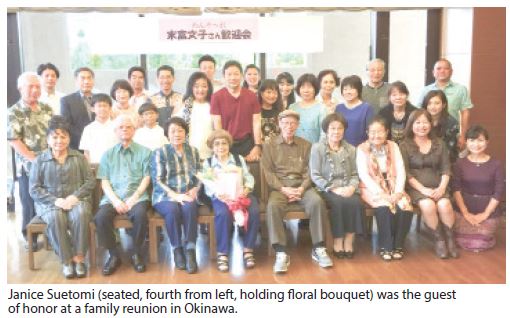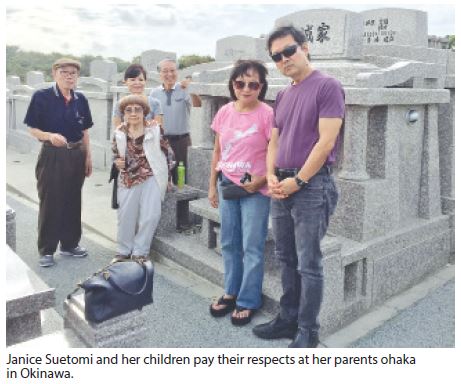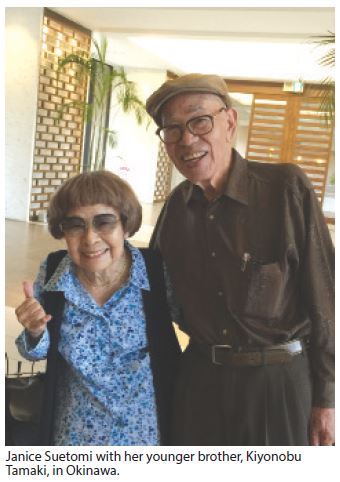
|
|
Living to Tell the Story of War and the Importance of Life and Peace
Published: Jan 2, 2020
|
Story by Jodie Chiemi Ching On June 23 in Japan’s southernmost prefecture of Okinawa, people will pause to remember those who died in a bloody battle that lasted only three months, but took over 200,000 lives. Irei no Hi, as it is referred to honors all who died - Okinawans, Americans, Japanese and other Allies. All lives are precious, they believe. And in Hawai‘i, Janice Suetomi, who was born Fumiko Tamaki in Okinawa, will remember, too, what she saw and what she experienced 73 years ago in her homeland. A Young Girl’s Dream As a young girl of 11, Suetomi dreamed of becoming an elementary school teacher. With the encouragement of her teachers, she studied hard and was the only student from her neighborhood of Taira in southern Okinawa’s Tomigusuku village to pass the entrance exam to the Okinawa First Girls’ High School. Of the 400 applicants from throughout the prefecture, only 40 students were accepted, and she was one of them. The school’s motto, “Aim for the Development of Highly Intellectual and Well-Cultivated Women,” inspired young Fumiko to pursue her dream. Everyone, except her parents, praised her achievement.

“I was the eighth child of 10 children from a poor family. After finishing elementary school, all my brothers and sisters went to work as housekeepers for other families and contributed to our family’s income,” explained Suetomi. Finally, at the urging of her teachers, her parents allowed her to continue school. The future looked bright for her . . . until the spring of 1945. Preparing for War On April 1, 1945, U.S. forces came ashore on Okinawa. On the eve of the Battle of Okinawa, the imperial army’s Okinawa Defense Unit was already on the island and had drafted civilians into the war effort. Their goal was to contain the invasion and prevent the Americans from bringing the land battle to the Japanese mainland. Japanese soldiers hid in underground caves from the Americans, who possessed far more firepower. The U.S. naval bombardment from offshore came to be known as the “Typhoon of Steel.” It would last only three months, but claim the lives of over 200,000 combatants and civilians. School buildings were converted into barracks. Students, male and female, at 21 secondary schools were mobilized for the war effort. Class hours were reduced. The students assisted the Japanese forces in building encampments and gathering food supplies. Their role then expanded and they soon found themselves on the battlefield. Anticipating further mobilization of the students to work in army hospitals, military surgeons began training female students between the ages of 15 and 19 to work as nurses. They came to be known as the Himeyuri, or the Lily Corps. The Tekketsu Kinötai — Blood and Iron Loyalist Student Corps — included male students between the ages of 14 and 19. They exposed themselves to heavy bombardment daily while transporting supplies, repairing bridges and electric cables and delivering telegraphs. The Okinawa First Girls’ High School and Okinawa Female Normal School were situated next to each other in the Asato district of Naha City. From these two schools, 18 teachers and 222 students were sent to the Okinawa Army Field Hospital in Haebaru Town. Suetomi and her teachers and fellow students had no clue of what awaited them. The field hospital turned out to be about 30 cave tunnels that had been dug into the mountains. A typical cave tunnel was dark and damp, about 6 feet high and 230 feet deep, lit only by candles. The “walls” were bare dirt and rock. Enduring Hell on Earth As the battle intensified, the caves became more and more crowded with wounded soldiers, who were placed on narrow bare-wood planks. Each patient was given a canteen of water, a small dish for food and a pot they used to relieve themselves. Every day, the Himeyuri nurses tended to their gruesome wounds, severed limbs and mental trauma. The imperial soldiers managed the caves and instructed Suetomi and her classmates of what to do. “We had to take care of the wounded soldiers and feed them. Soldiers would deliver food — usually rice in buckets. We would make onigiri (riceballs) and feed the soldiers. We ate that, too. There was no meat. Once in a while, we were lucky and had vegetables, but very little,” she recalled. She still remembers the gruesome and unsanitary conditions. They were short on supplies, and food and water were becoming scarce. Many of the wounded soldiers screamed and moaned in pain. Their wounds had gotten infected, and their mouths and ears were infested with maggots. In order to stretch their limited supplies, bandages were changed once every two weeks. The nurses also had to remove the maggots from the soldiers’ wounds as part of their job. Anesthesia wasn’t always available, so the Himeyuri nurses had to help restrain the soldiers while their limbs were being amputated. They then had to bury the severed limbs. Suetomi said the nurses also had to bury the dead. They could hear the gunfire and explosions right outside the cave during the day, so they waited until night. “We had to bury bodies at night, and we had to work quickly,” Suetomi said. Her hands still remember how she moved the dirt to bury the soldiers. “There was no time to relax; we just focused on our work.” Even at night, there was still the risk of gunfire. So stressful were their duties — and lacking proper nutrition — the girls stopped menstruating during that time. Suetomi’s daughter, Nancy, said it was a “life and death situation on a daily basis” for her mom. “I know my mother had it tough during the war, hiding in caves and eating grass. She even got hit [by shrapnel] in the back,” leaving Suetomi with an inch-long scar on her back. Evacuating to Itoman In May 1945, U.S. forces advanced toward Okinawa’s ancient capital of Shuri, where Japan’s army was headquartered. On May 25, the Haebaru Army Field Hospital occupants were ordered to evacuate the cave. While some students helped the patients able to walk, others carried supplies, documents and medicine in their rucksacks. They headed south, braving a barrage of shells. The combination of bombs and persistent rain had turned the roads into muddy swamps. Corpses lay scattered on the ground and severely wounded patients whose legs had been amputated crawled in the mud, trying to escape the shelling. Those patients unable to walk at all were given poison and left to die in the cave, perhaps out of compassion, or maybe to prevent them from revealing vital information if captured by the American soldiers. Two gravely injured students could not be moved. They, too, were given poison, she said, and left to die. Those able to continue on headed toward Ihara in Itoman, where the Okinawa Peace Memorial Park now sits, a symbol of peace. The civilians had taken shelter in many of the gama, or natural caves, in the area. Suetomi said the Japanese army ordered the civilians hiding in six gama to get out so that the caves could be converted into a new field hospital.

By then, most of the medical supplies had been depleted and the caves ceased to function as a hospital. Although they were unsuitable for receiving injured soldiers, the students continued to carry out their tasks amid the shelling, securing food and water and transporting messages. One day, there was a call from outside the cave where Suetomi was hiding with the Japanese soldiers and other student nurses. The appeal was from American soldiers. “Come out; we have food.” No one left the cave. Suddenly, a tear gas grenade was thrown into the cave. Suetomi said she and her fellow nurses hit the ground, facedown. The grenade exploded, hurling the bodies of the soldiers standing in the cave upon them. In her section of the cave she estimates that there were a few hundred people hiding. Only four survived that attack. |
At midnight on June 18, the students were issued a deactivation order at the Army Field Hospital. With U.S. forces closing in, there was heavy bombardment everywhere they looked. Nevertheless, the students were forced to leave the cave and fend for themselves. They had worked so hard to save the lives of the soldiers, believing Japan would win, so they were mortified to learn that they were losing the battle and being thrown out into the battlefield.
The Himeyuri nurses suffered their greatest casualties from then on. Surrender and Refuge in a Concentration Camp A week after being deactivated, the Himeyuri student nurses were hiding near Cape Kyan, the southernmost tip of Okinawa island. American troops had surrounded them. The students found a grenade and decided that they would pull the pin and die together. They had been told that they would be raped and killed if they were captured. However, their teacher, Seizen Nakasone, convinced them to surrender. He assured them that if he felt something was wrong, he would signal for them to jump off the cliff. All the men were told to take off their shirts. They then became separated from their teacher, Suetomi said. The American soldiers transported her to a refugee camp in Nago. The fighting was over, but life for the Okinawan people was still a living hell. About 100,000 people were crammed into three camps in the northern area of Nago. With unsanitary conditions and the lack of nourishing food, people died of malaria or starved to death. Many bodies were buried in mass graves. Suetomi’s daughter recalled a story her mother had told her about the camps. “My mom saw a couple and she knew their daughter. She couldn’t speak to them because she buried the daughter [in Haebaru] who lost her leg and died. She was scared to tell them what happened.” While in the camp, Suetomi suffered a bout of malaria. A kind American soldier nursed her back to health. She never learned his name, however. “If I knew his name, I would fly to wherever he is and thank him for saving my life,” she said. Suetomi finally got word that her family was alive and was told of their location. She left the camp to search for them. It was an emotional reunion when she found them after months of not knowing if they had survived the fighting. The Tamaki family decided to return to their home in Taira. When they arrived, however, other families had occupied their house. They explained to the squatters that they were the owners of the house. “This is war!” the squatters responded. “There is no such thing as ‘your house.’” So, the Tamaki family lived in a barn adjacent to a friend’s house until they were finally able to move back into their home. A New Life When Suetomi was able to work, she took a job in the motor pool section at the Tengan Army Base, which is today known as Camp Courtney, a U.S. Marine Corps base in Uruma City. Her job required that she get a driver’s license. There were 97 men and three women studying to get their license. Two of the women decided to drop out, leaving only Suetomi in contention. She passed the testing and became the first woman in Okinawa to receive a driver’s license. A woman driver on the island of Okinawa turned lots of heads, she recalled. Suetomi drove the U.S. military officers to their meetings. “I used to drive the captains and sergeants around and waited outside the building by my car while they had their meeting. That’s when all the guys would come and flirt with me,” she said with a big smile. And that is how she met her future husband, James Isamu Suetomi, a civil service auto mechanic who worked in the motor pool in Okinawa and became the luckiest of all the men who wanted a date with her. A New Home and Family James Suetomi and Fumiko Tamaki married and settled in Hawai‘i, where they raised five children and, eventually, had 11 grandchildren. Fumiko adopted an English name, Janice, and even became a naturalized American citizen. James passed away in 1984, but Janice continues to live an active life. Now 89 years old, she continues to be surrounded by a loving family. “I grew up hearing war stories from my mom when we were little, but they didn’t really have that much of an impact on me until I toured the Himeyuri Peace Museum in 2015,” said Betty Stubblefield, Suetomi’s eldest daughter. “We went through each room, read through every document, looked at each photo (of the students) and watched all the videos. After exiting the museum, I cried my heart out. Even after we went back to our hotel room, whenever I thought about what my mom went through, I would burst into uncontrollable tears,” she continued.

“That was the very first time I truly understood even a small portion of what she had lived through,” Stubblefield said. There is one word that Suetomi’s children and grandchildren all use to describe her. “Tough.” Amy Ching, her youngest daughter, recalls that her mother was very strict and “sometimes overprotective in raising us. She always worked hard at giving us the best in life. The war has impacted her in a positive way. She is always strong, lifting everyone else up and encouraging us to do our best.” Suetomi was always ahead of her time, flexing her independence as a woman. It’s a quality her grandson, Elton Gray, respects and admires. “She married a Japanese American from Hawai‘i. That was a huge deal in her day. She embraced America and even named her children American names: Betty, Roy, Esther, Nancy and Amy. And she changed her own name from Fumiko to Janice. “She is kind and tough. She appreciates everything around her, but also carried the wisdom and knowledge from her experiences. I love my grandma,” said Gray. A Plea for Peace Janice Suetomi has one wish for the younger generation: “Please help one another so we can live in a world of peace,” she says. She shares her experience, not to place blame on anyone, but in the hope that we will all live in peace. Suetomi’s granddaughter, Chelsea Stubblefield, talks about her grandmother’s compassion. “I remember her telling me that wartime was hard. She didn’t want her children to struggle like she did, so she worked hard to raise them with love and happiness, giving them the best of everything. She laughed and reminisced about one of her friends telling her that her children were her delicate flower garden. She treasured them so.” Fittingly, Suetomi enjoys nurturing tulips in the garden of her Central O‘ahu home. If all human beings can see one another as delicate flowers in need of nurturing, we can live in a world that is a beautiful, peaceful garden filled with love and compassion.

Sources: The Hawai'i Herald, Vol 39, No.11, Friday, June 1, 2018 My tour of Bunker #20 and Museum @ Haebaru, April 26, 2019 My visit to the Okinawa Peace Memorial Park, April 15, 2019 My visit to Cape Kyan, May 2, 2019 My tour of the Himeyuri Peace Museum, April 12, 2019 |
©2019 Contact: ClickOkinawa.com
